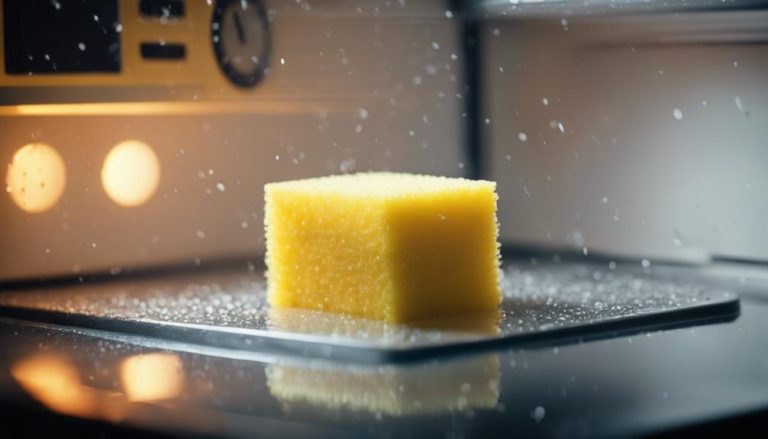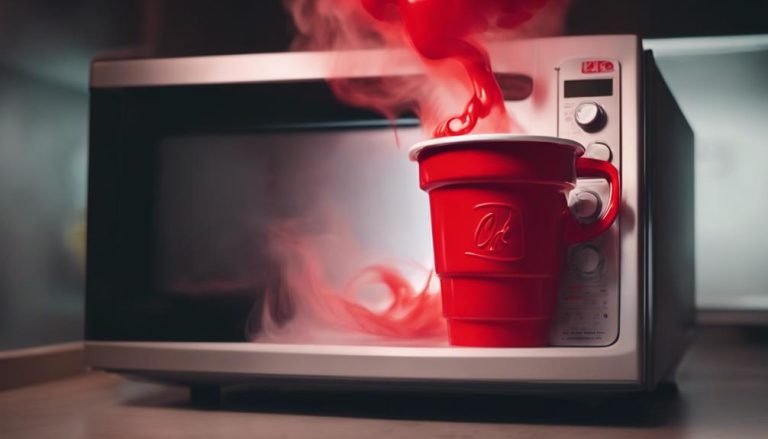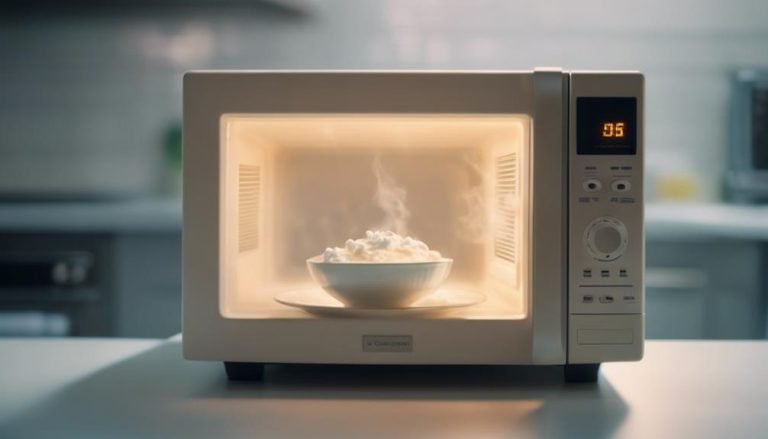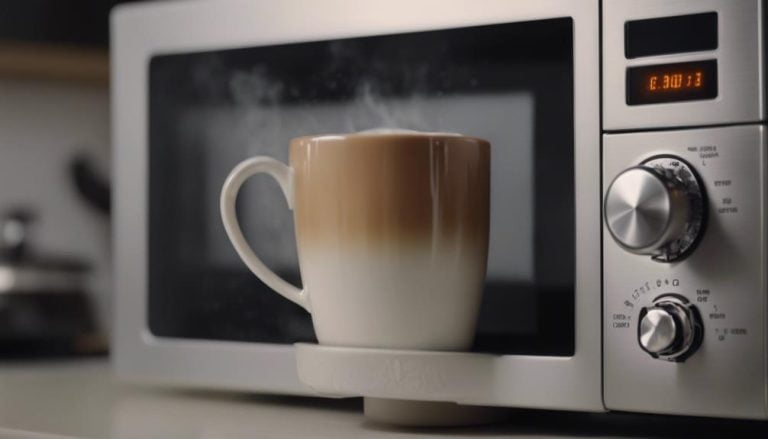Can You Microwave Breast Milk
No, you should not microwave breast milk. Microwaving breast milk can cause the milk to heat unevenly, leading to hot spots that can burn your baby's mouth.
Additionally, microwaving can destroy the beneficial antibodies and nutrients present in breast milk.
It is safer to warm breast milk by placing the bottle in a bowl of warm water or using a bottle warmer specifically designed for breast milk.
Key Takeaways
- Microwaving breast milk poses risks like hot spots and nutrient loss.
- Avoid microwaving to preserve immunological components and probiotic bacteria.
- Protein denaturation and inactivation can harm breast milk's bioactive properties.
- Opt for safe warming methods to maintain breast milk's nutritional benefits.
Risks of Microwaving Breast Milk
Microwaving breast milk poses significant risks to both the nutritional integrity and safety of the milk for infants. When breast milk is heated in a microwave, it can create uneven temperatures, leading to dangerous hot spots that may scald a baby's mouth. This uneven heating can also cause a loss of essential components in the milk, such as probiotic bacteria and immunological factors, which are crucial for the baby's health.
The FDA advises against microwaving breast milk due to these associated risks. Therefore, it is important to prioritize the safety and well-being of infants by avoiding the use of microwaves for heating breast milk to prevent potential harm and nutrient loss.
Impact on Nutrient Composition
The process of heating breast milk in a microwave can significantly alter the nutrient composition, impacting crucial components essential for infant health.
Key Points:
- Microwaving breast milk can degrade immunological and anti-inflammatory components.
- Essential probiotic bacteria may be destroyed, affecting gut health.
- White blood cells, vital for anti-infective properties, can be eliminated.
- Heating breast milk unevenly in a microwave can accelerate the loss of nutritional benefits.
It is essential to handle breast milk carefully to preserve the healthy qualities it offers. Microwaving can lead to uneven heating, potentially diminishing the nutritional value and benefits, including the crucial presence of white blood cells that support the infant's immune system.
Effects on Breast Milk Proteins
When microwaving breast milk, there is a risk of denaturing and inactivating essential bioactive proteins, potentially reducing the milk's immune-boosting properties.
The heating process in a microwave can compromise the effectiveness and bioavailability of crucial proteins necessary for infant growth and development.
Therefore, understanding the impact of microwaving on breast milk proteins is vital in ensuring the preservation of its nutritional value for the infant.
Effects on Nutrient Content
Heating breast milk using a microwave has been shown to adversely affect the essential bioactive proteins crucial for infant development. When considering the effects on breast milk proteins during the warming process, it is essential to understand the impact on the overall nutrient content.
- Denaturation: Microwaving can denature and inactivate bioactive proteins in breast milk.
- Protein Breakdown: High temperatures in a microwave may lead to the breakdown of the protein structure in breast milk.
- Loss of Essential Components: Heating breast milk in a microwave can result in a loss of essential amino acids and enzymes.
- Reduced Bioavailability: Microwaving breast milk may reduce the bioavailability and effectiveness of proteins for the baby.
Microwaving Temperature Impact
Considering the impact of microwaving temperature on breast milk proteins, it is crucial to acknowledge the potential denaturation and inactivation of bioactive proteins essential for infant health. High temperatures in a microwave can break down these proteins, affecting their nutritional value and potentially leading to the loss of important immunological components. To preserve the integrity and functionality of breast milk proteins, alternative methods like warm water or cool running water should be considered for heating breast milk. These methods can help maintain the bioactive properties of the milk while ensuring that the proteins remain intact. Heating breast milk at room temperature can also be a safer option to prevent overheating and protein degradation.
| Heating Method | Impact on Proteins | Safety Concerns |
|---|---|---|
| Warm Water | Minimal protein damage | Safe for heating |
| Cool Running Water | Minimal protein damage | Safe for heating |
| Microwave Breast | High protein breakdown | Uneven heating |
| Room Temperature | Minimal protein damage | Slow heating process |
Protein Denaturation Risk
Proper handling techniques are essential to mitigate the risk of protein denaturation in breast milk, safeguarding the nutritional integrity crucial for infant health.
Key Points:
- Warm Water Bath: Using a warm water bath is a safer method to heat breast milk without risking protein denaturation.
- Avoid Running Water: Avoid using running water to warm breast milk as it can lead to uneven heating and potential protein damage.
- Gentle Heat: Applying gentle heat through warm water helps maintain the structural integrity of proteins in breast milk.
- Preserving Immunological Properties: Preventing protein denaturation by avoiding the microwave preserves the immunological properties of breast milk essential for the infant's health.
Dangers of Hot Spots
Microwaving breast milk poses a significant risk of creating hot spots, which can potentially harm infants by causing scalding temperatures. These hot spots can occur due to uneven heating in the microwave, leading to localized overheating and nutrient loss in the breast milk.
It is crucial to understand the dangers of hot spots when microwaving breast milk and to implement proper microwave safety tips to ensure the health and well-being of the baby.
Hot Spots Risk
When heating breast milk in a microwave, it is crucial to be aware of the potential dangers posed by the formation of hot spots. Hot spots can lead to uneven heating, scalding a baby's mouth, and causing harm.
To prevent hot spots when using a bottle warmer, consider gradually adding warmer water to the container and swirling the milk gently to distribute heat evenly. This method helps protect and preserve the nutrients in breast milk.
It is important to prioritize safety over convenience and avoid microwaving breast milk to minimize the risks associated with hot spots and nutrient loss.
Uneven Heating Dangers
The risk of hot spots during the heating of breast milk in a microwave underscores the potential dangers associated with uneven heating, particularly concerning the safety and nutritional quality for infants. Hot spots can cause uneven temperature distribution in the milk, leading to areas that are too hot and others that remain cool. This non-uniform heating poses a threat to the baby's delicate mouth and can also affect the composition of human milk. White blood cells, which are crucial for the baby's immune system, can be destroyed by hot spots, diminishing the protective properties of the milk. To highlight the dangers of hot spots further, consider the following table:
| Hot Spots Risks | Impact on Breast Milk |
|---|---|
| Scalding baby's mouth | Degradation of essential components |
| Destruction of white blood cells | Accelerated quality deterioration |
| Uneven temperature distribution | Loss of immunological components |
| Potential harm to infants | Impact on probiotic bacteria |
Microwave Safety Tips
Heating breast milk in a microwave poses significant risks due to the potential formation of hot spots that can compromise the safety and nutritional quality essential for infants. To ensure the safe warming of breast milk, consider the following tips:
- Avoid direct microwaving: Instead of microwaving breast milk, opt for alternative methods to heat it.
- Use a bowl of warm water: Place the container of milk in a bowl of warm water to heat it gently.
- Gradually add water: When warming breast milk in a container of warm water, add water gradually to control the temperature.
- Make sure to test the temperature: Always test the temperature of the milk before feeding it to the baby to prevent any burns or discomfort.
Alternative Safe Warming Methods
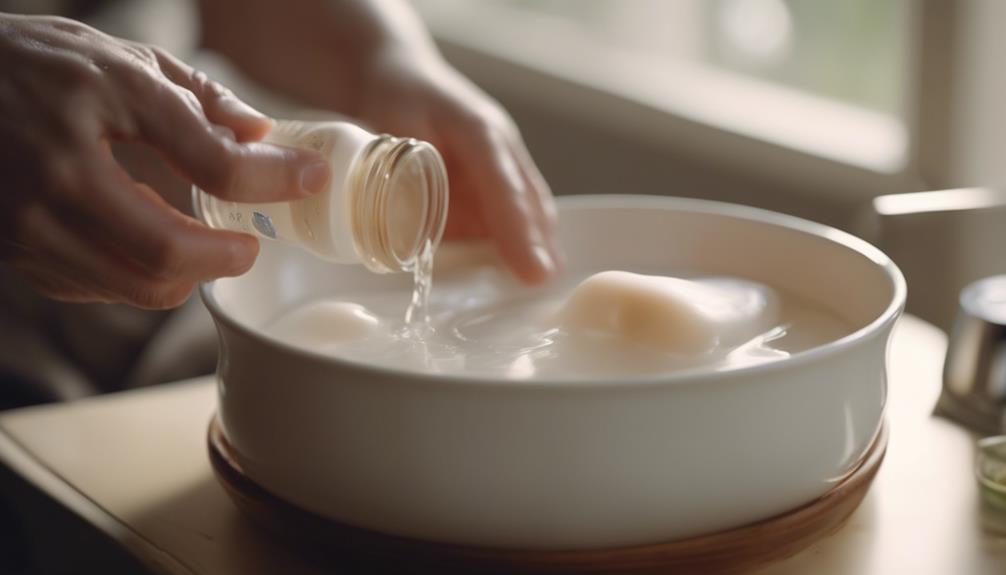
Consider utilizing a bottle warmer or other approved methods to safely warm breastmilk for your baby's consumption. Some safe alternatives include warming breastmilk in a container of water until the milk reaches the desired temperature or placing the container under running water. It's essential to avoid using a microwave as it can heat the milk unevenly, potentially destroying essential nutrients and beneficial immune factors like white blood cells. To provide a clearer picture, the following table outlines the recommended safe warming methods for breastmilk:
| Method | Description | Benefits |
|---|---|---|
| Bottle Warmer | Provides precise temperature control | Preserves nutrients |
| Warm Water Bath | Placing container in warm water | Gentle and gradual warming process |
| Warm Faucet | Running warm water over the container | Quick and efficient method |
Guidelines for Warming Breast Milk
When ensuring the optimal quality and safety of breast milk for your baby's consumption, it is essential to adhere to specific guidelines for warming the milk effectively.
Guidelines for Warming Breast Milk:
- Avoid Microwaving: Microwaving can create hot spots and lead to nutrient loss.
- Temperature Control: Warm breast milk below 104 degrees Fahrenheit for quality preservation.
- Safe Warming Methods: Consider using a bottle warmer or warm water techniques.
- Temperature Testing: Always check the temperature on your wrist to ensure it's lukewarm before feeding.
Conclusion and Recommendations
In light of the risks associated with microwaving breast milk and the importance of preserving its nutritional value, it is imperative to explore safe and effective warming methods for the optimal care of your baby.
Microwaving breast milk can create hot spots that may harm infants and degrade essential components. The FDA advises against heating breast milk in a microwave to maintain its immunological and anti-inflammatory properties.
To ensure the safety and quality of breast milk, it is recommended to use alternatives such as a bottle warmer or warm water bath. By following expert guidance and avoiding microwaving breast milk, parents can ensure that their baby receives milk warmed to room temperature without compromising its benefits, unlike with infant formula.
Frequently Asked Questions
Can Microwaving Breast Milk Cause It to Lose Its Beneficial Antibodies and Enzymes?
Microwaving breast milk can compromise its beneficial antibodies and enzymes due to high temperatures leading to nutrient loss. Microwave safety for breastfeeding includes preserving immune support by avoiding this heating method for optimal antibody preservation and enzyme activity retention.
Is It Safe to Use a Bottle Warmer Instead of a Microwave to Warm Breast Milk?
Utilizing bottle warmers for heating breast milk offers effective temperature control, ensuring safe warming without compromising nutritional value. While microwaves provide convenience, bottle warmers distribute heat evenly, preserving antibodies and nutrients. Sterilization concerns are minimized with bottle warmers.
What Are the Potential Risks of Microwaving Breast Milk Multiple Times?
Temperature concerns arise when microwaving breast milk multiple times, leading to nutrient degradation, uneven heating, and potential microbial growth risks. This practice can compromise essential components, including immunological properties, probiotic bacteria, fats, and enzymes critical for infant health.
How Does Microwaving Breast Milk Affect Its Taste and Smell?
Microwaving breast milk can alter its taste and smell by affecting the lipase enzymes responsible for fat breakdown. This change may result in a soapy or rancid flavor, impacting the milk's appeal to infants. Temperature control is crucial for preserving taste and smell.
Are There Any Specific Guidelines for Thawing Frozen Breast Milk in a Microwave?
When thawing frozen breast milk in a microwave, ensure temperature control to avoid hot spots that could harm your baby's mouth. Prioritize nutrient preservation by opting for safer thawing methods like warm water or the refrigerator for efficient and safe thawing.
Conclusion
In conclusion, microwaving breast milk poses risks to its quality and safety, as it can create hot spots and lead to a loss of essential nutrients and proteins. It is important to prioritize the wellbeing of infants by following safe warming methods recommended by health experts.
While microwaving may seem convenient, the potential harm it can cause to breast milk outweighs any perceived benefits. It is best to prioritize the health and safety of the baby by avoiding microwaving breast milk.



